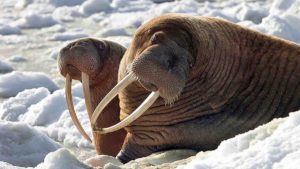The McClung plays a big role in the UT experience for many members of our campus community. To highlight these connections, we asked UT faculty and staff to tell us about an object in our collection that has impacted their classes, their students, or their own exploration within the museum.
 “Choosing a favorite object from our collections is so hard since I get the privilege of teaching, researching, and interacting with so many of them. However, my all-time favorite object might be the ivory walrus. When I first stumbled upon it doing research I could not believe how beautiful and intricately detailed it was considering its small size. We know so little about it which leaves me with so many questions regarding its origin as well as its creator. It is such a beautiful and delicate piece that is so different from many of the pieces I teach with regularly. I find this piece extremely delightful in person, it has such a whimsical quality to it that makes it stand out for me.” – Sadie Counts, McClung Museum Graduate Assistant
“Choosing a favorite object from our collections is so hard since I get the privilege of teaching, researching, and interacting with so many of them. However, my all-time favorite object might be the ivory walrus. When I first stumbled upon it doing research I could not believe how beautiful and intricately detailed it was considering its small size. We know so little about it which leaves me with so many questions regarding its origin as well as its creator. It is such a beautiful and delicate piece that is so different from many of the pieces I teach with regularly. I find this piece extremely delightful in person, it has such a whimsical quality to it that makes it stand out for me.” – Sadie Counts, McClung Museum Graduate Assistant
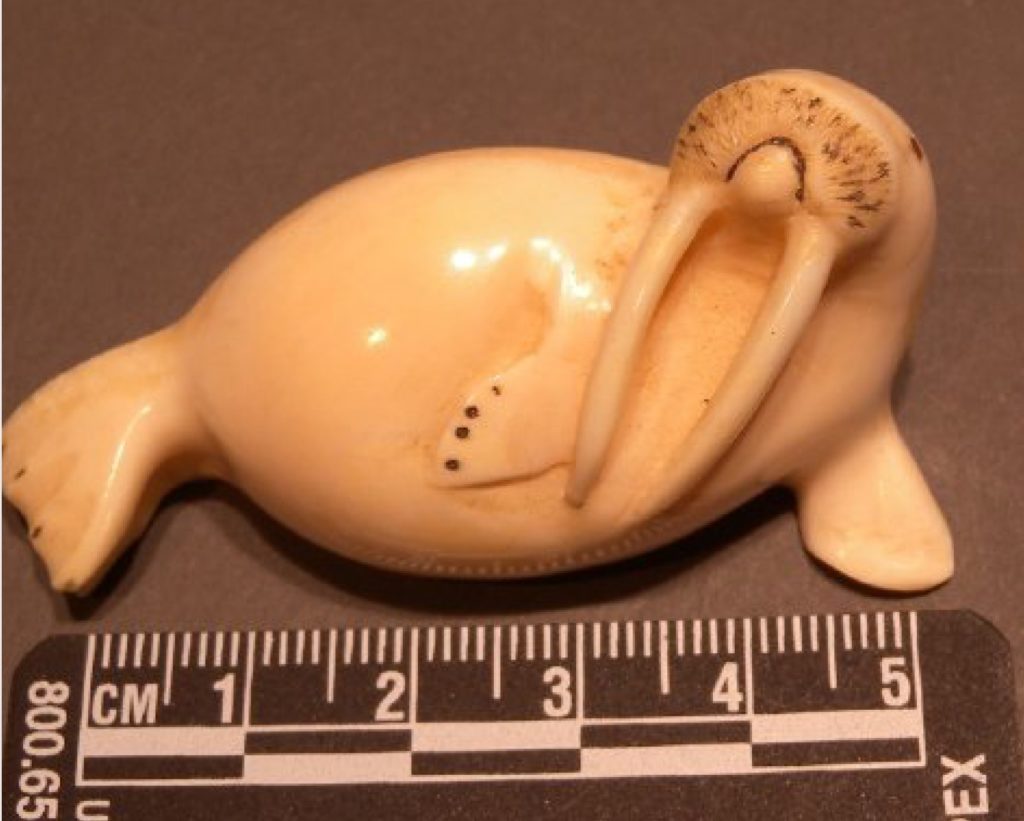
Effigy, late 1800s, Canadian Inuit, Ivory, McClung Museum Purchase, 1990.2.3.
As Counts stated, little is known about the carving housed at the McClung. However, museum staff can ascertain information by researching similar objects at other museums. In fact, the exchange of data about objects that occurs between museums is important research for many collecting institutions.
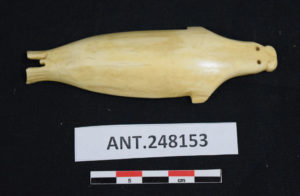
ANT.248153 Digital Image: Yale Peabody Museum of Natural History; photo by E. Gredell
The Yale Peabody Museum has many carvings that are similar to the one held by the McClung. They attribute these objects to Native Arctic tribal communities, and most likely Inuit in Alaska and Canada. However, other Native Arctic groups, like the Iñupiat and Yupik of Greenland and North America and the Chuchki and the Koryak of Russia, produce ivory carvings as well. Carvings like this were traditionally used for rituals, playthings, buttons, or clothing fasteners. Later, designs were modified to sell to tourists as a livelihood.
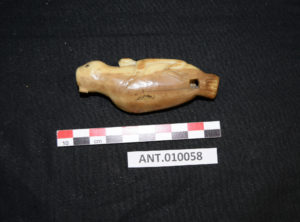
ANT.010058 Digital Image: Yale Peabody Museum of Natural History: photo by Zordan, J. R., 2017
The size of the McClung’s carving indicates that it would have been easily transportable. The pose of the walrus is unique, and differs from those housed at Yale. While the objects at Yale are in elongated positions, such as a walrus lying down on his belly fully extended, the reclining position of the one at the McClung incites wonder. Why did the artist chose to depict the animal this way and what is the significance?
Historically, the walrus has been an incredibly important part of life for Native groups living in the Arctic. When hunted, all parts of the walrus are used. Its meat is one of the main foods that sustain Native Arctic families. Oil from walrus blubber is burned for warmth and light. The hide is used to make rope, houses, and boat coverings, and the intestines are used to make waterproof parkas. The flippers are often fermented and served as a delicacy, and tusk ivory and bones are used to make tools as well as art.
Walruses are not currently considered an endangered species. While their population did dwindle in the 18th and 19th centuries, this was due to over-hunting by American and European whalers and sealers, not traditional hunting and use by Native groups. Commercial hunting of walruses has since been banned, but traditional hunting is allowed for Native Arctic communities.
The aforementioned use of ivory from walrus tusks, however, is fraught. Ivory is internationally regulated because the poaching and over-hunting of elephants solely for their tusks has put elephants on the brink of extinction. However, ivory regulations have also impacted the use of walrus tusks by Native Arctic groups. Bans on elephant ivory has largely resulted in bans on all ivory. This lack of nuance has been difficult for many Native Arctic communities. Native Arctic artisans often make their livelihood from selling carvings made from walrus ivory, and even today, it is a main source of income for many Inuit and Yupik people. Plus, traditional walrus hunting (unlike elephant poaching) utilizes the full animal – which is less ethically troubling to many and more vital to the communities that rely upon the animal. As a result, Alaska has made efforts to lift bans on walrus ivory for Native communities to support the importance of walrus ivory to their livelihoods and heritage.
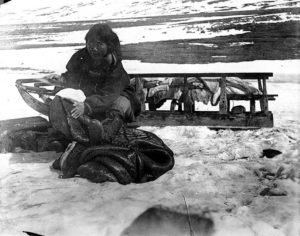
Native Alaskan woman dresses walrus. Photo by John Nathan Cobb.
The walrus not only has economic and survival importance to Native Arctic groups, but also cultural significance. In Inuit mythology, A’akuluujjusi is the great creator/ mother goddess. When she made animals, she originally created the caribou with tusks and the walrus with antlers. She then saw that both of these animals became too dangerous for the Inuit hunters, so she swapped the antlers to the caribou and the tusks to the walrus. She then deemed the walrus to be perfect. Aside from carvings, the walrus is still an important motif in contemporary Inuit art.
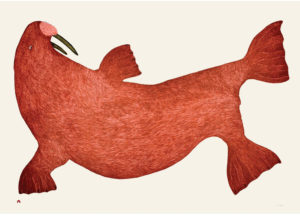
Tim Pitsiulak, “Red Walrus”, c. 2013. Lithograph. Image courtesy of Inuit Art Zone.
If you’re interested in seeing more examples of walrus ivory carving, check out the video of the exhibition Carving Life: Walrus Ivory Carvings from the Bering Sea put on at the CUNY Queensborough Community College Art Gallery that opened in October 2017 and ran through January 2018 featuring art from Alaskan Inuit artists.
